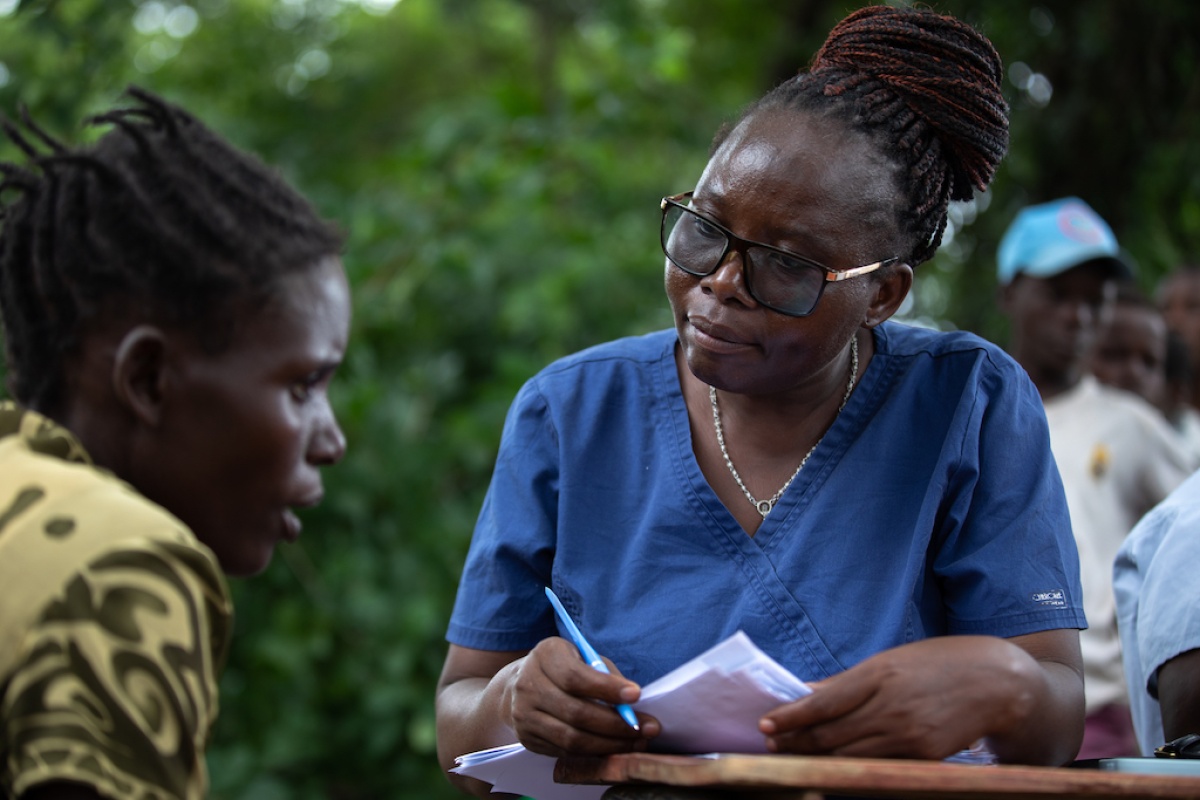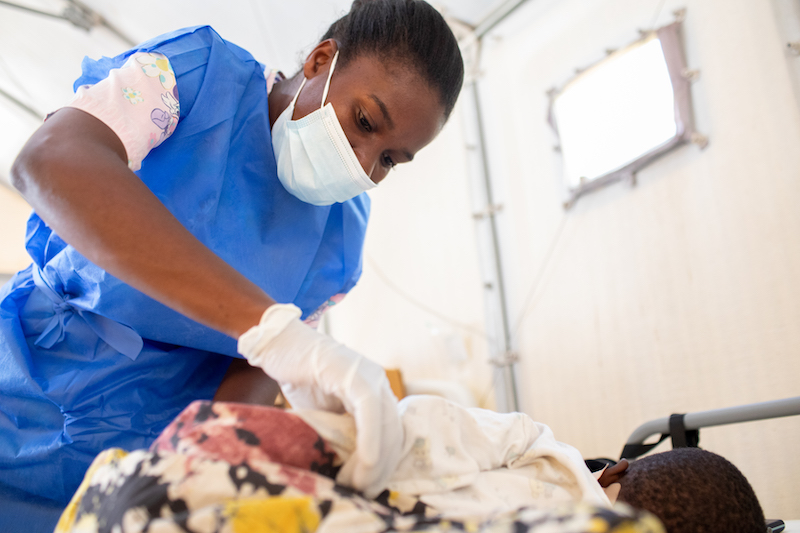Nurses, Crucial to the Global Health Workforce, Face Dwindling Ranks as Demand Grows
Shortages, pay gaps, systemic barriers threaten nursing, health systems, and patient health
Posted on May 9, 2023

Zack DeClerck/PIH
In honor of National Nurses Week, the following essay was co-authored by Partners In Health CEO Dr. Sheila Davis; Cory McMahon, chief nursing officer; and Isaac Mphande, primary health care manager, Abwenzi Pa Za Umoyo (APZU/PIH Malawi)
Nurses, the backbone of the global health workforce, are facing a crisis. That means patients are bound to suffer.
Even before COVID-19 struck, nurse and midwife shortages were between 7 million, according to the World Health Organization, and 30 million, based on an analysis for the Global Burden of Disease study, which took into account additional factors to determine need.
Even with this considerable gap in estimates, the shortfall is significant, and predominantly impacts low and middle-income countries. Now more than three years into the pandemic, there have been widespread departures from the nursing profession, further fracturing already weakened health systems.
Beyond shortages, the distribution of the existing nursing workforce threatens the equitable and effective delivery of care. More than 80% of the world’s nurses work in countries that contain only half of the global population. The pandemic exacerbated this inequity: high-income countries, also facing high burnout and nursing shortages, increased recruitment of nurses from low- and middle-income countries—further amplifying gaps in nursing supply and demand.
As nurses make up the majority of global health care personnel and provide almost 80% of hands-on care worldwide, a strong nursing workforce is integral to health system resiliency, pandemic preparedness and response, ongoing essential health care needs, and the ability to deliver on universal health care.
At Partners In Health, 52% of our clinical staff are nurses, yet nurses provide 75% of our patient care. PIH supports 1,626 nurses—88% of whom are female—across 11 countries. Globally, those most impacted by disparities in nursing availability and accessibility are—as usual—the patients, families, and communities that are most vulnerable. Despite general agreement that the world needs more nurses (and quickly), there are significant structural barriers to entering and remaining in the nursing workforce. Addressing these barriers is essential to improving patient care and outcomes and health systems broadly.
Case Study: Malawi
In Malawi, where PIH has worked since 2007, it can take seven years to earn a nursing degree. Even then, there is no promise of a job—despite the national need. Nurses who do secure jobs may find themselves bombarded, expected to see up to 75 or 100 per day at a busy health center. When nurses are unable to obtain employment, this directly impacts the ability to attract nurses to the profession, further contributing to workforce shortages. This understaffing, alongside other dire working conditions, strain nurse retention, recruitment, and the delivery of quality care.
Despite these obstacles, Malawi has tripled its number of trained nurses and midwives. Each year, hundreds of well-qualified nurses graduate from school, prepared to enter the workforce. Although there is a 54% vacancy rate among nursing and midwifery positions within the public health system, only 70% of trained nurses and midwives are absorbed—there are currently thousands of qualified nurses without jobs in Malawi. However, the public health system is still in dire need of more nurses.
If there is a global nursing shortage, why then should there be difficulty integrating nurses into health systems?
This astounding misalignment is due to International Monetary Fund (IMF) imposed austerity measures, which place strict limits on the number of new public sector workers hired and their salaries. These rules impact multiple professions, including teachers and nurses. So, despite an enormous nursing shortage within clinics and hospitals, new nursing graduates are blocked from being hired by the public sector, forcing many to leave the country to find work. Furthermore, the low pay and high workload of the existing workforce means the cost of the austerity is borne by health workers and the health and well-being of the people.
Recently, Malawi’s National Organization of Nurses and Midwives has been assisting unemployed nurses in seeking jobs outside the country. More than 3,000 nurses matched to jobs elsewhere—including the United States and other high-income countries—but the government blocked visas to prevent their departure. However, this does not prevent nurses from leaving on their own to pursue their careers and livelihoods.

Photo: Zack DeClerck/PIH
Nurse-Driven Innovations
Beyond barriers to entry, a diverse range of challenges prevent the retention and support of nurses in the workforce. These obstacles include under-resourced work environments with high volumes of patients, insufficient supplies, no space or time to take breaks, inadequate access to education and training, and insufficient pay, among others. Achieving a new path forward requires a reimagined future, one in which nurses are recognized as experts and have opportunities to develop their careers while also receiving appropriate pay for their critical work. It will require a paradigm shift built upon the voices of nurses, and others serving on the frontlines, sitting at decision-making tables.
Across our care delivery sites, PIH is working to formally define specialty areas and advanced practice nursing, enhance professional development opportunities, and establish career pathways that also keep nurses at the bedside. We are developing nursing fellowship programs that bridge the gap between academic and clinical practice, promote nurse-led innovations to care delivery, address burnout through staff wellness programs, provide dignified housing and other social support, and engage in policy change.
PIH’s nurses are at the forefront of innovative care delivery programs, mentorship and leadership initiatives, and national and global policy efforts to impact broader change. Our integrated maternal child health program in Haiti (J9) is led by an interdisciplinary team of nurses and midwives. From 2018 to 2021, 2,229 women and 1,912 children benefitted from the J9 program. And even during the pandemic and more recent instability, J9 has sustained its enrollment of and services for expectant and new mothers and their babies.
Nursing Centers of Excellence in Liberia and Haiti serve as hubs for professional development and clinical education and mentorship, bridging the gap from theory to practice. At the University of Global Health Equity’s Center for Nursing and Midwifery, nurses and midwives gain training in leadership, policy, and advocacy, as we make plans for a school of nursing and midwifery in the near future.
In Liberia, Lesotho, Rwanda, Sierra Leone, and Haiti, we are working closely with national regulatory bodies to support efforts that define scopes of practice and establish national standards and curricula. Furthermore, we are engaging directly—in Malawi and elsewhere—with multilateral organizations to address structural barriers that prevent optimal patient care and to influence equitable resource allocation, workforce distribution and specialization, and strategies to attract, recruit, and retain qualified nurses and other health care professionals to meet present and future needs.
A Workforce of Experts
Across PIH and the globe, nurses and midwives deliver care amid difficult circumstances—from natural disasters to violence—and continue to show up as clinical experts, care connectors, educators, innovators, leaders, and compassionate caregivers at the bedside.
As experts who provide the majority of care, and because of their proximity to patients, nurses should lead the discussion about structural changes needed to fortify the workforce and advance health care as a human right for all. However, health care practice still perpetuates hierarchies that too often minimize nurse leadership. Only 71% of countries have a national nursing leadership position with influence on nursing and health policy. As 90% of the nursing workforce is female, these power dynamics are patterned by gender inequities. Although women hold 70% of health care jobs globally, they only occupy 25% of health leadership roles—and women are, of course, differentially impacted based on social status and other privilege.
In Rwanda last June, we witnessed the power of nurse leaders coming together through the Global Nurse Executive Fellowship (GNEF) program. Nurses from Haiti, Liberia, Sierra Leone, Malawi, Rwanda, Peru, and Lesotho shared challenges, exchanged ideas, and learned from each other. The innovative solutions that emerged from this collaboration highlight the importance and untapped potential of nurse leadership. Our work across PIH proves what is possible when nurses are engaged in and lead efforts to improve the delivery of expert, dignified, and compassionate patient care.

